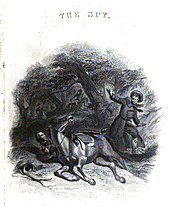Seventy-Six (novel)
Historically distinguished for its pioneering use of colloquial language, Yankee dialect, battle scene realism, high characterization, stream of consciousness narrative, profanity, and depictions of sex and romance, the novel foreshadowed and influenced later American writers.
A response to James Fenimore Cooper's The Spy (1821) and inspired by Neal's own work on A History of the American Revolution (1819), the novel was written over twenty-seven days in early 1822.
"[1] His story begins in New Jersey in the early winter of 1776, with residents fearing British and Hessian raiding parties following George Washington's retreat through the area.
While the brothers are in training, the Oadley home is burned by Hessians, who wound the elder Jonathan and kidnap Arthur's love interest, Mary Austin.
Mary Austin reappears and is reunited with Arthur in Philadelphia, but expresses romantic interest in the older Robert, whom Jonathan calls "a profligate—a voluptuary—a sensualist, perhaps".
With the narrator removed from the battlefield, news of the war continues to come from letters and visits from Archibald and Arthur, who are now serving in the Southern theater.
Like Neal's novels Randolph and Errata (both published the same year), the hero of Seventy-Six successfully kills another in a duel and suffers the rest of his life in consequence.
[10] Archibald is haunted by violent nightmares, preternatural phenomena, and other Gothic story elements that he interprets as coming from his dueling victim, Clinton.
[28] Battle scenes in the novel are told using long sentences of multiple qualifiers to express the narrator's anxiety in a pioneering use of what would be called stream of consciousness a century later.
[31] The way the reader's perspective is heavily distorted by the conditions of battle and soldiers' conflicting emotions are expressed were not replicated until The Red Badge of Courage by Stephen Crane in 1895.
[41] Decades later he described the experience of inspiration: I had got charged to the muzzle with the doings of our Revolutionary fathers, while writing my portion of "Allen's History," and wanted only the hint, or touch, that Cooper gave in passing, to go off like a Leyden jar, and empty myself at once of all the hoarded enthusiasm I had been bottling up, for three or four years.
[46] Neal considered his 1822–1823 novels "a complete series; a course of experiment" in declamation (Logan), narrative (Seventy-Six), epistolary (Randolph), and colloquialism (Errata).
[19] Three historical novels about the American Revolution predate Seventy-Six: The Female Review by Herman Mann (1797), The Champions of Freedom by Daniel Woodworth (1816), and The Spy by Cooper (1821).
[49] Playwright Harry Watkins, at the suggestion of writer Cornelius Mathews, asked Neal in 1875 about drafting a play based on Seventy-Six to coincide with the 1876 US centennial.
[53] The book enjoyed a generally favorable reception in the US and UK[54] that fashioned Neal as Cooper's chief rival for recognition as America's leading novelist.
[61] Near the end of his life, Neal believed Seventy-Six to be his best novel,[62] calling it "a spirited sketch of the Revolutionary war, full of incident, character, and truthfulness".
"[63] The novel's most severe review was published in The Port Folio by John Elihu Hall, whom Neal had attacked in another publication four years earlier.
How can the writer imagine that any decent person will allow a book to remain in his library which abounds, as these volumes do, in gross and needless violations of decorum?
"[65] A negative review in The Monthly Magazine focused on the novel's depictions of violence, calling it "rude and boisterous; every chapter being covered with blood, or heaving with the throes of lacerated flesh.
"[66] Of the profanities used in the novel: "In addition to the regularly-formed oaths, which are very numerous, the name of God is invoked in every page: and in such a manner as to make it difficult to discover whether the author meant to pray or to swear.
"[66] The Magazine of Foreign Literature bemoaned: "If the author would only condescend to write intelligibly ... he would yet ... become eminent as a novelist", but allowed that "yet, with all this, there is so much talent, so much of surprisingly amusing madness, that we cannot blame it as we ought.
[69] The scholarship that exists largely praises the book's powerful and groundbreaking moments, but bemoans that those strengths are outweighed by the plot's incoherence and disjointedness.
[70] The preface by scholar Robert Bain to the novel's 1971 edition uplifts the story's groundbreaking elements, but blames its construction and overly sensational tangents for reducing its readability.
[71] This consensus view reflects an 1849 essay by Edgar Allan Poe,[62] who felt that "the repeated failures of John Neal as regards the construction" of his books puts readers "in no mood to give the author credit for the vivid sensations which have been aroused during the progress of perusal".
"[73] While accepting the validity of this consensus assessment, literature scholar Jeffrey Insko argued the book is nevertheless interesting "not despite, but precisely because of [its] incoherencies", which is "itself the meaning of [Neal's] fiction".
[78] He concluded, "Seventy-Six is a novel that well deserves to be resuscitated, and that makes one a bit exasperated with the public perversity that throws such work by the wayside and cherishes for a name the early, relatively inferior Spy of Cooper.



